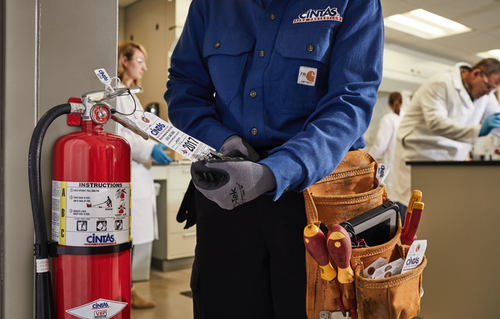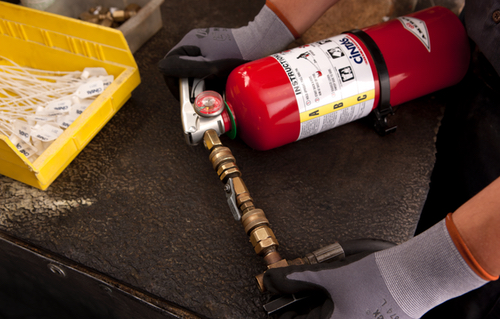When it comes to suppressing a fire and minimizing damage, automatic sprinkler systems often come to mind for their critical role in fire protection. Their instant response not only slows a fire’s progress before professional help arrives, they also help keep people and property safe. What’s more, having a sprinkler system at your facility can help you meet building regulations, code requirements and insurance requirements, and can also help reduce your insurance premiums as a result.
So for most businesses, the question isn’t whether you should have a sprinkler system installed — it’s which type of sprinkler system is appropriate for your particular facility. With every commercial building having different fire protection requirements, it’s helpful to be familiar with the types of fire sprinklers available today, as well as the applications they’re most useful for.
Four common types of commercial sprinkler systems:
WET PIPE SYSTEMS
Overview
Wet pipe systems are the most common type of fire sprinkler systems, with water always in the pipes from an automatic source.
How it works
When a fire occurs and the sprinkler head is exposed to enough heat, the bulb in this head will burst and water will be discharged. Not all sprinkler heads are activated at once, which helps contain any damage to only the areas where a fire hazard is present.
Ideal application
Because of their simple actuation and cost-effectiveness, wet pipe systems are usually the first type considered when selecting a sprinkler system. However, if the building where the sprinkler piping is located isn’t conditioned to at least 40 degrees Fahrenheit or higher, then other systems should be considered to address the risk of freezing water.
DRY PIPE SYSTEMS
Overview
Dry pipe systems are filled with pressurized air, and they will only release water to the pipes when that air is flushed through the system and the sprinkler heads are activated.
How it works
When an automatic sprinkler is exposed to enough heat, the valve opens and allows air to escape — which causes the pressure in the pipes to drop and frees the water to flow through the piping. While this does add to fire response time, it’s a necessary feature for unheated buildings and properties.
Ideal application
Dry pipe systems are typically used in spaces such as warehouses in the north and outdoor parking garages, where the temperatures could be low enough to freeze water in the pipes and cause the system to be ineffective.
PRE-ACTION SYSTEMS
Overview
Pre-action sprinkler systems are filled with air, just like with a dry pipe system. But unlike dry systems, pre-action systems require two events to occur before water is released — adding extra protection from false alarms that could cause damage associated with water spouting.
How it works
Water is held back by an electronically operated pre-action valve, which is controlled by a separate heat or smoke detection source. This system must detect smoke or heat before water can be released into the system piping. After the valve is opened, each sprinkler head is turned on individually and then water will flow onto the fire.
Ideal application
These systems are most frequently used in spaces with water-sensitive equipment where accidental discharge from sprinklers would cause severe damage and expense — such as data centers, libraries and art museums.
DELUGE SYSTEMS
Overview
Unlike with conventional sprinkler systems, the sprinkler heads are constantly open with a deluge system and water is held back with a valve. This system provides a very fast reaction time, because water in the pipework is immediately discharged from every head once the deluge valve has been activated.
How it works
Much like a pre-action system, the deluge valve prevents water from filling the system until another type of detection system is triggered, such as smoke detection. And once a fire is detected, water is pumped through all discharge devices without relying on the bulb in the sprinkler head to burst.
Ideal application
These systems are typically installed in high hazard locations requiring a constant application of water over a large area to suppress a fire and prevent it from spreading.
When selecting which sprinkler system is appropriate for your business, it’s important to consider the pros and cons of each. And remember: a sprinkler system won’t do any good if it’s not well-maintained and ready to activate in a fire emergency. Cintas Fire Protection technicians inspect, test and service all kinds of automatic sprinkler systems, and they’re always here to help. Find out more here.
CINTAS CAN HELP YOU STAY BETTER PREPARED
- On-site assessment to discuss fire protection solutions for your business*
- Customized service dates that fit your busy schedule*
- Routine testing, inspection and maintenance of your fire protection equipment*

 On-site assessment to discuss fire protection solutions for your business*
On-site assessment to discuss fire protection solutions for your business*
 Customized service dates that fit your busy schedule*
Customized service dates that fit your busy schedule*
 Routine testing, inspection and maintenance of your fire protection equipment*
Routine testing, inspection and maintenance of your fire protection equipment*
*Certain services may not be available in all markets